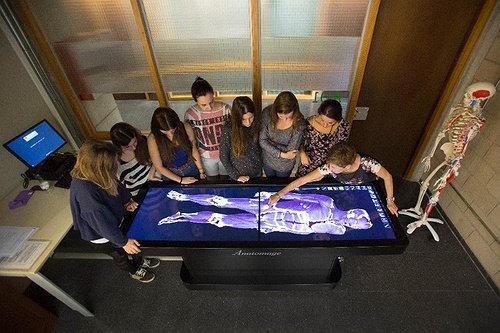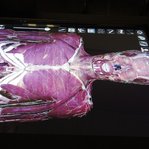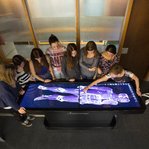Selden, NY - November 9, 2015 - It’s the most technologically advanced anatomy visualization system in the world, according to its manufacturer, and Suffolk County Community College has one of only three in the northeastern United States. Welcome to teaching and learning in the 21st century.
The Anatomage virtual dissection table is being adopted at leading medical schools and institutions to allow life-like and never before available interaction and visualization of the human body and its systems.
The table – about the size of a hospital bed with a touchscreen surface -- uses three-dimensional imagery from digitally scanned specimens to allow students to perform a life-size, virtual dissection via touchscreen interface. The table can render limitless views of the human body in flawless detail.
Students can zoom in on or rotate different structures and virtually remove individual organs, according to Suffolk County Community College Professor of Biology Dr. Peter Smith.
“The table is a remarkable technological tool that provides students with a 360-degree view of anatomical structures and their relationship to one another,” Smith said.
“We can look at the body through three dimensional visualization, “Smith explained, “and all of the body’s structures can be annotated. This is what teaching anatomy in the 21st century is all about.”
Suffolk County Community College Biology Department Chair Dr. Rosa Gambier summed up the unique versatility of the new technology.
"The Anatomage table is a true 21st century teaching tool. It permits Biology students not only to study Human anatomy but it is a good addition to general biology classes that include animal anatomy. It includes in its programming the possibility of virtual dissection of cats and dogs. The table will help to reduce the use of preserved specimens, a more humane and sustainable approach to the study of vertebrate anatomy," Gambier said.
“The table,” explained Suffolk County Community College President Dr. Shaun L. McKay, “while advanced, is also a natural extension of what students are familiar with because it functions much like a tablet computer. We are extremely proud to bring this new tool to our college and to our students while fulfilling our mission of incorporating innovative teaching and learning strategies into our classrooms."
The technology allows students to visualize skeletal tissues, muscles, organs and soft tissue and further customize the interaction by virtually slicing, layering and segmenting the anatomy. The selections can be rotated or flipped to accommodate any viewpoint.
Work with an actual cadaver requires many chemicals, there needs to be a facility to house them (Suffolk County Community College was the only community college in New York with a cadaver lab), there is a great deal of regulation in working with cadavers, and there is recurring costs associated with them.
With the Anatomage table, one table can give countless students the ability to work with a body, enlarge or rotate systems and bisect and remove parts.
According to Anatomage, the manufacturer of the table, Suffolk County Community College is one of only 21 colleges nationally, the only college in New York State and one of only three in the northeastern United States to be teaching utilizing the virtual dissection table.













